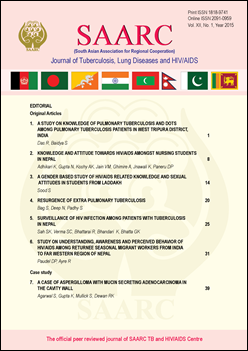Study on Understanding, Awareness and Perceived Behavior of HIV/AIDS among Returnee Seasonal Migrant Workers from India to Far Western Region of Nepal
DOI:
https://doi.org/10.3126/saarctb.v12i1.15940Keywords:
Understanding, Awareness, Perceived, Behavior, HIV/AIDS, Seasonal, Migrant, WorkersAbstract
Introduction: HIV/AIDS is an emerging challenge to public health, social development and modern human civilization. Thousands of Nepalese people are migrating to India and other countries every year in order to seek employment. Migrants are often a medically underserved population and are getting more exposed to unsafe sexual activities, increasing their risk for HIV/AIDS. Awareness is a powerful weapon to combat such problems like HIV/AIDS. Hence this study was conducted to explore the understanding, awareness and perceived behavior of migrant workers on HIV/AIDS.
Methodology: This Population based cross-sectional study was carried out in the border area of Far- Western region of Nepal. Altogether 372 returnee migrants who were selected randomly were interviewed after obtaining their written consent. Aggregation of correct knowledge on HIV/AIDS was considered as good understanding, positive perception as good perceived behavior and good understanding with positive perceived behavior as good awareness. Data were analyzed using SPSS-16 applying appropriate statistics. Criterion for statistical significance was set at test value P < 0.05.
Results: Total, 372 male migrant workers (mean age ± SD: 29.6 ± 1.9 years; range: 18-47 years) participated in the study. Majority (29.84%) were 28-32 years. Half (50.81%) were from primary and informal educational background and 74.20 percent were Hindus. About 41.94 percent of the participants’ earning was < 3000 NRs. /month and 53.22 percent were scheduled caste. About 46.77 percent were porters followed by 29.84 percent who work as construction workers. Almost 81percent had heard about the HIV/AIDS with 45.9 percent reporting virus as an etiology. Similarly 65 percent reported that unsafe sexual contact is the major mode of HIV transmission and one–quarter had the idea that HIV cannot be transmitted through hugging/kissing or shaking hands. Almost 80.0% reported that condom use is the most important preventive measure. Nearly half (49.20%) were found to be aware of HIV/AIDS. Age of participants (χ2= 13.09, p <0.001), educational background (χ2=10.65, p <0.001), religion (χ2= 8.03, p <0.02), monthly income (χ2= 12.38, p <0.001) and nature of job/work performed (χ2 = 7, p<0.02) during staying in India were found to be significant factors affecting the level of awareness.
Conclusion: Nearly half of the participants were found to be aware on HIV/AIDS. The level of awareness was significantly affected by the age of participants, educational background, religion, monthly income and nature of job/work performed during staying in India. Awareness creating package programs like behavior change communication (BCC) on HIV/AIDS are supportive to decrease the vulnerability of HIV/ AIDS among migrant workers.
SAARC J TUBER LUNG DIS HIV/AIDS, 2015; 12(1), page: 31-38
Downloads
Downloads
Published
How to Cite
Issue
Section
License
Copyright © SAARC Tuberculosis and HIV/AIDS Centre (STAC), all rights reserved, no part of this publication may be reproduced, stored in a retrieval system or transmitted in any form or by any means without prior permission of the STAC.




